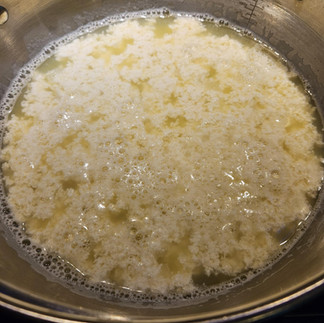“Whey Too Easy” – A Farmer’s Cheese Adventure With Goat Milk
- Jul 24
- 3 min read
Woke up this morning after sleeping in full zero-gravity astronaut mode (gotta love adjustable beds!) because I pulled a chest muscle yesterday… courtesy of Chris deciding to pick me up mid-shenanigans like we were auditioning for a rom-com stunt double reel! Managed to roll out of bed like a log with dignity (ish) to let the birds out... only to find my two turkey hen besties locked in a dramatic squabble that felt very personal. Feathers were puffed. Side-eyes were exchanged. I was not emotionally prepared. Finally back inside for coffee, opened the fridge, and was immediately stared down by 1.5 gallons of goat milk (that a dear friend gifted us) like: “You forgot about me, didn’t you?” So yeah. Cheese day. Because today, I’m a homesteader, a referee, and a dairy technician!
What Is Farmer’s Cheese?
Farmer’s cheese is the low-maintenance cousin of fancy, aged varieties. It’s soft, spreadable, and surprisingly versatile. No need for special cultures, aging rooms, or mystical cheese rituals. Just fresh milk, acid, and the will to stir.
What You’ll Need (and keep in mind that there are many different recipes, but this is how we do it):
1 gallon fresh goat milk
1/2 cup apple cider vinegar (we prefer the taste of the ACV vs. anything else)
Salt to taste
Optional additions: herbs, garlic, pepper flakes, or anything your cheese-loving heart desires
A colander
Cheese Cloth
A stainless steel pot (NOTE: Stainless steel is largely inert, meaning it doesn't react with the milk or other ingredients. This is critical for preserving the natural flavor, color, and characteristics of the cheese. Other reactive metals, like aluminum or unlined copper, can interact with the acidity in the cheese, leading to undesirable metallic tastes or discoloration.)
A container to strain your whey into if you want to save it. We save it and give it to our Chicken and Turkey flocks the following day. They LOVE it!
The Method to the Madness
Warm the Milk up slowly: Pour your goat milk into a stainless steel pot and heat gently to about 195°F. No boiling! Think spa day, not volcano. Stir... a LOT!
Introduce the Apple Cider Vinegar: Once the milk’s warm and you reached 195F, turn off the heat and slowly stir in your vinegar. Curds will begin to separate from the whey. It’s like a middle school breakup, but more nutritious.
Let It Rest: Cover the pot and let it sit for 10–15 minutes. Use this time to thank your goats, or your friend or practice your dramatic cheese-naming voice.
Strain the Curds: Line a colander with cheesecloth or a clean flour sack towel. Pour the mixture in and let it drain. For a firmer cheese, press it a bit. For a fluffier finish, let gravity do the work. I let mine sit for about 25-30 minutes and add some whey back in if I feel it's not the right consistency.
Season and Store: Stir in salt and any extras, then refrigerate your creation. It’s ready to spread, crumble, or inhale directly from the container (we won’t judge).
Bonus Tips
Use leftover whey to soak chicken feed, nourish plants, or add a tangy twist to smoothies if you’re brave.
Flour sack towels are reusable and work beautifully in place of cheesecloth.
More Apple Cider Vinegar equals more tang. More draining time equals firmer texture. Experiment and let your taste buds decide. I put my last batch in a blender so that I would get a creamy texture for crackers and Lasagna, it turned out marvelous!
Final Thoughts
Farmer’s cheese is one of those homestead wins that feels like a small miracle. It’s simple, satisfying, and just rustic enough to feel like a kitchen triumph.





























Comments